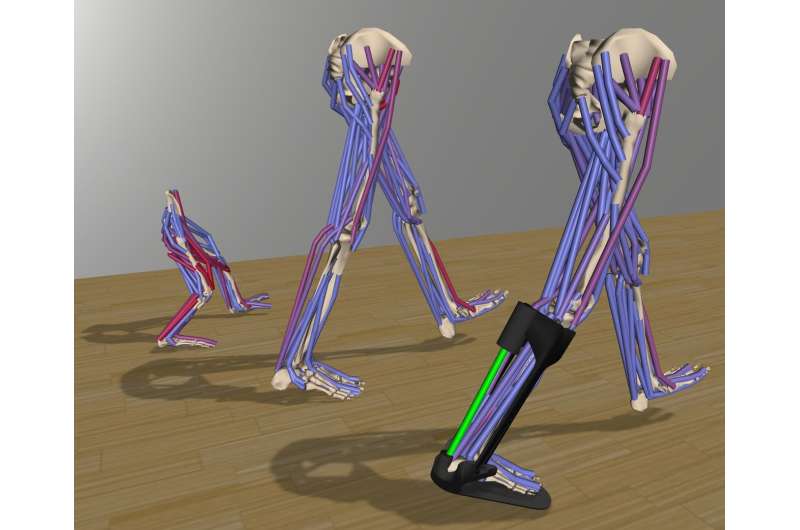Movement is fundamental to human and animal life, emerging through interaction of complex neural, muscular, and skeletal systems. OpenSim is open-source software that unites state-of-the-art models and methods from biology, neuroscience, mechanics, robotics, and computer science to create fast and accurate physics-based simulations of movement. OpenSim complements experiments by computing muscle forces and other quantities that are difficult to measure, and enables prediction of movements such as bipedal locomotion in human ancestors and neuromuscular adaptations to exoskeletons or orthopaedic surgeries. Credit: Seth et al.
An open-source movement simulator that has already helped solve problems in medicine, paleontology, and animal locomotion has been expanded and improved, according to a new publication in the open-access journal PLOS Computational Biology. The software, called OpenSim, has been developed by a team at Stanford University, led by first authors Ajay Seth, Jennifer Hicks, and Thomas Uchida, with contributions from users around the world. The new paper reviews the software's wide range of applications and describes the improvements that can increase its utility even further.
The major challenges in creating movements "in silico" include formulating the underlying mathematical equations and ensuring the solution is accurate when calculating variables that are difficult to measure experimentally, such as the metabolic consumption of individual muscles and the stretch and recoil of tendons during movement. Physics-based models enable prediction of novel movements, both adaptive and maladaptive, such as excess hip rotation in response to leg muscle weakness. OpenSim combines methods from biology, neuroscience, mechanics, and robotics to address these challenges and create fast and accurate simulations of movement.
OpenSim has already been put to use determining whether Australopithecus afarensis had sufficient grip strength to make certain tools, based on fossilized bone discoveries; developing strategies to prevent ankle injuries during athletic performance; and optimizing a wearable robotic device for long jumps. Additional applications include predicting the locomotion patterns of extinct species and planning tendon-lengthening surgery for children with cerebral palsy.
Recent improvements include addition of more accurate models of muscle dynamics, joint kinematics, and assistive devices, which will aid in rehabilitation studies; the ability to create custom studies by combining existing tools in new ways; tools for importing motion-capture data in order to test simulations against experiments; and modern visualization tools for creating insightful animations of movement.
"The software is like a Swiss Army knife for the movement scientist," said the lead authors. "It allows researchers with no special expertise in biomechanics to perform powerful and accurate simulations to test hypotheses, visualize solutions to problems, and communicate ideas. Because it incorporates decades of research about how humans and other animals move, and is constantly being augmented and enhanced by the community of users from so many different fields, OpenSim can accelerate discoveries in any field in which biological movement plays a role."
More information: Seth A, Hicks JL, Uchida TK, Habib A, Dembia CL, Dunne JJ, et al. (2018) OpenSim: Simulating musculoskeletal dynamics and neuromuscular control to study human and animal movement. PLoS Comput Biol 14(7): e1006223. doi.org/10.1371/journal.pcbi.1006223
Journal information: PLoS Computational Biology
Provided by Public Library of Science























